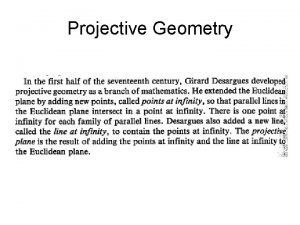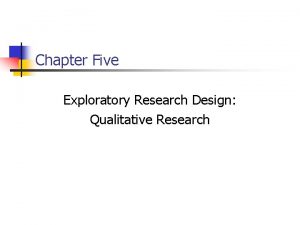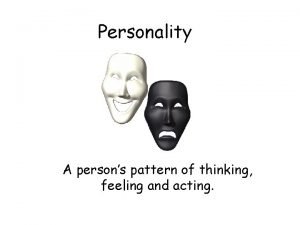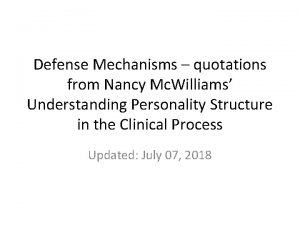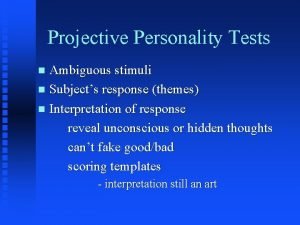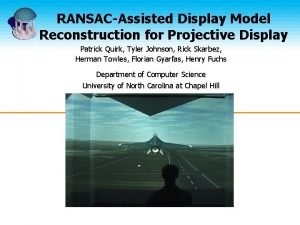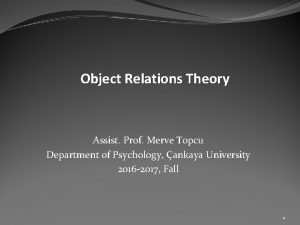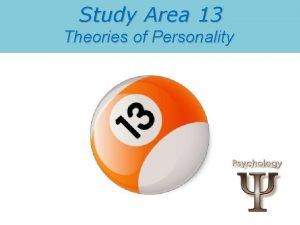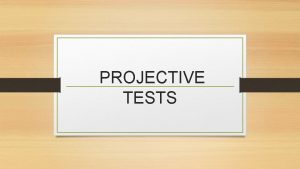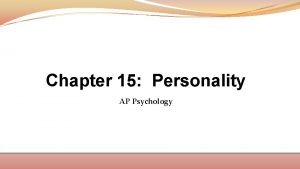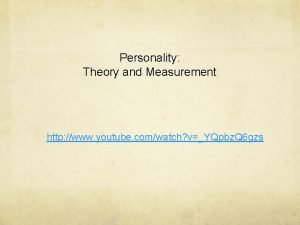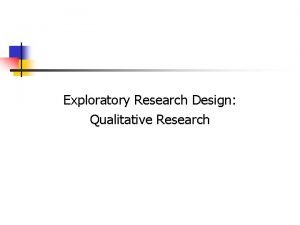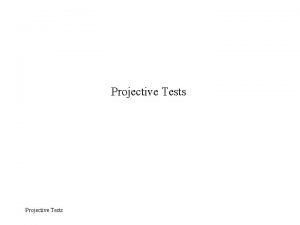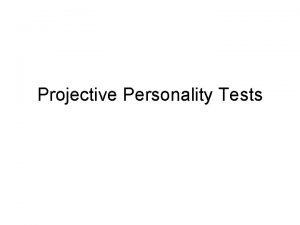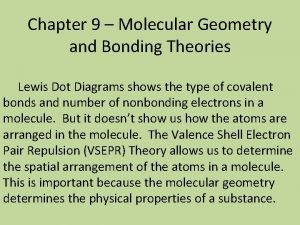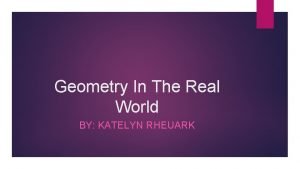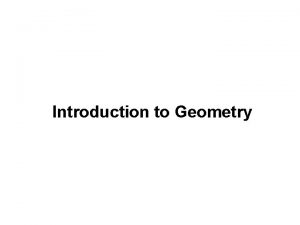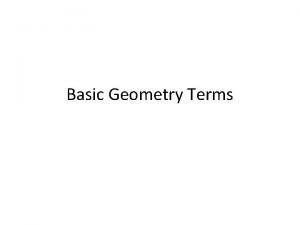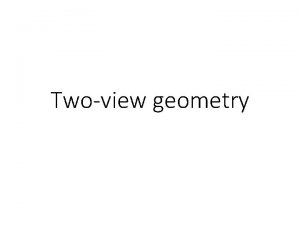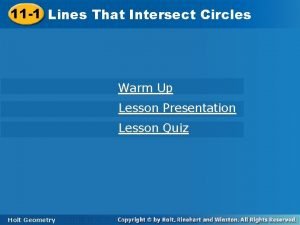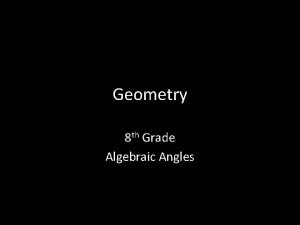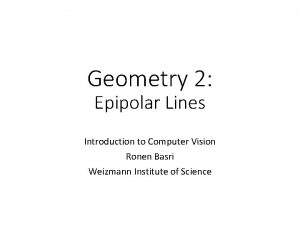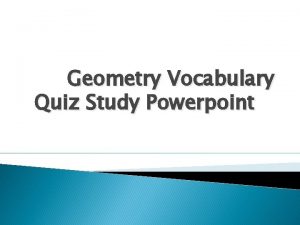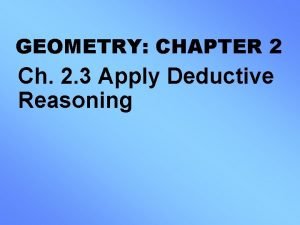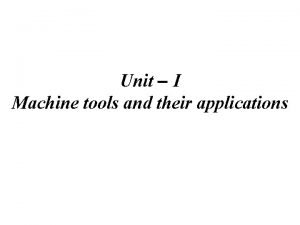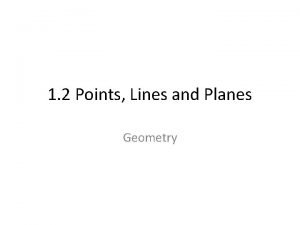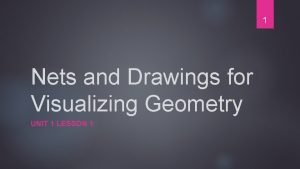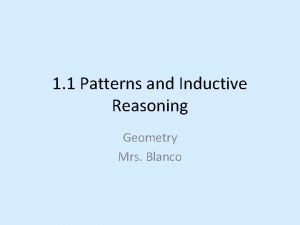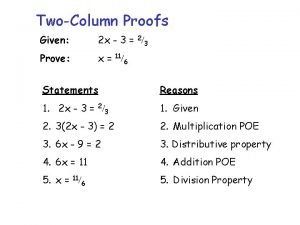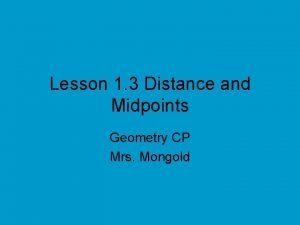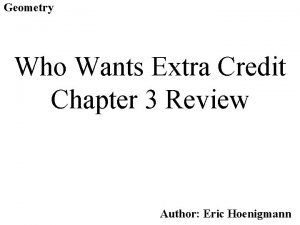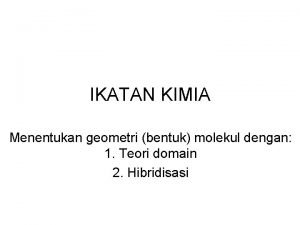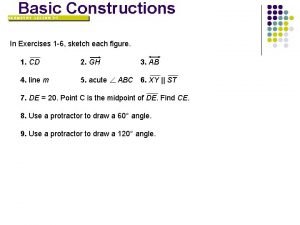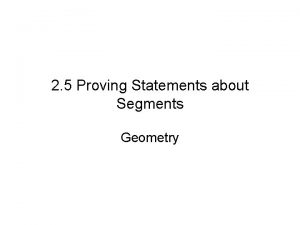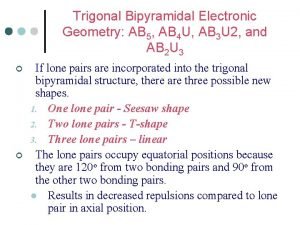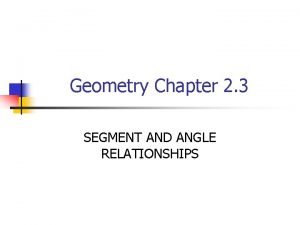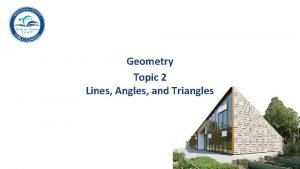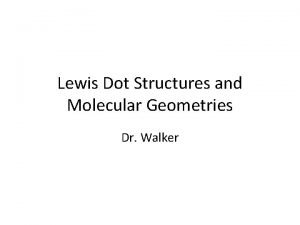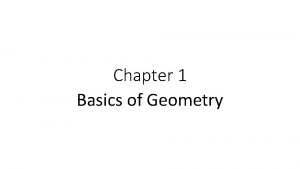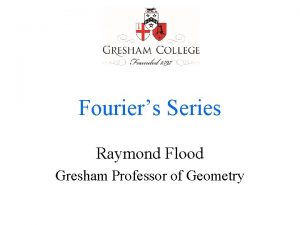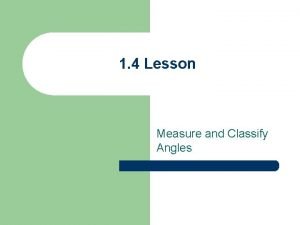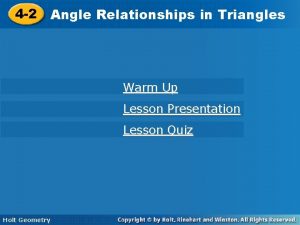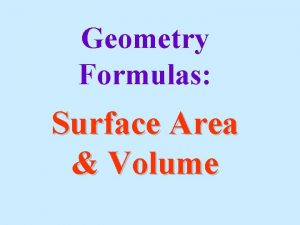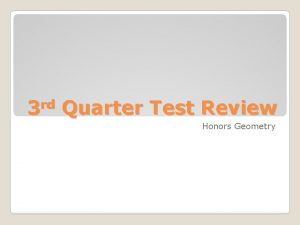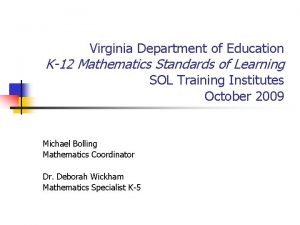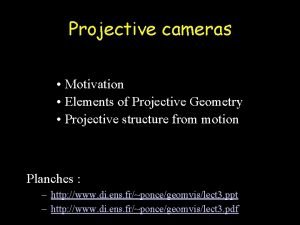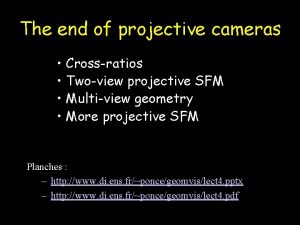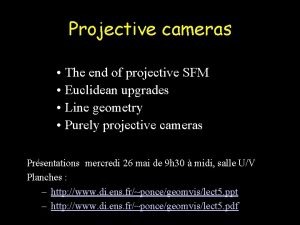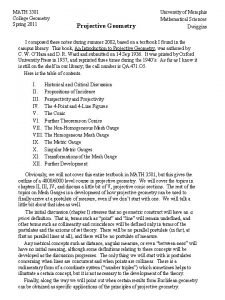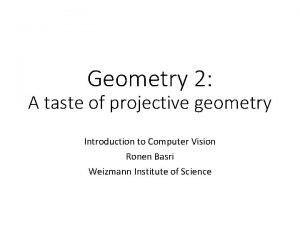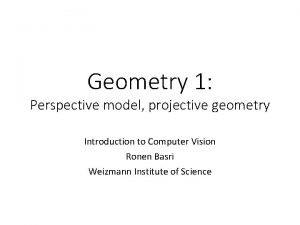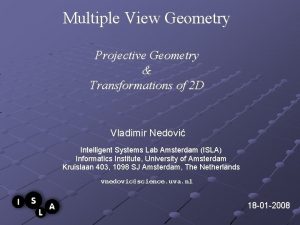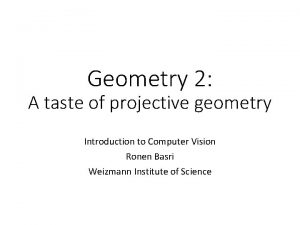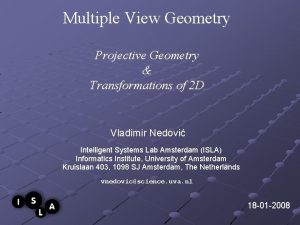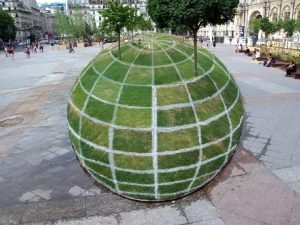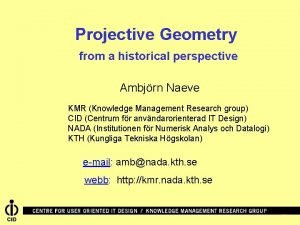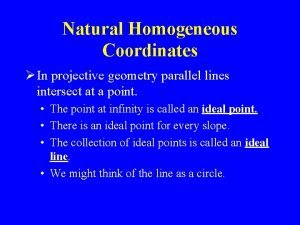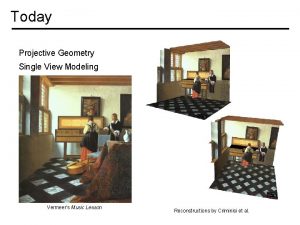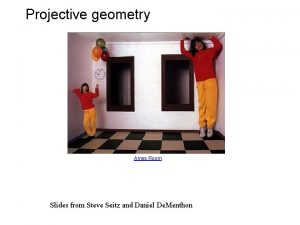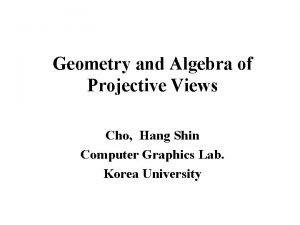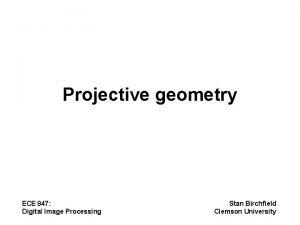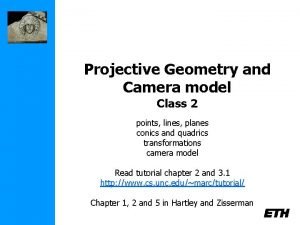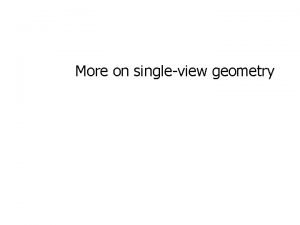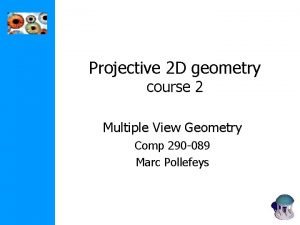Projective Geometry Projective Geometry Projective Geometry Projective Geometry




















































![Typical Calibration P[3][4], B[3][3], b[3] Typical Calibration P[3][4], B[3][3], b[3]](https://slidetodoc.com/presentation_image_h/0b514f34a92010beb42079f067895dd9/image-53.jpg)







- Slides: 60

Projective Geometry

Projective Geometry

Projective Geometry

Projective Geometry

Projective Geometry

Projection

Projection Vanishing lines m and n

Projective Plane (Extended Plane)

Projective Plane How? ? ? Ordinary plane

Point Representation A point in the projective plane is represented as a ray in R 3

Projective Geometry

Homogeneous coordinates Homogeneous representation of 2 D points and lines The point x lies on the line l if and only if Note that scale is unimportant for incidence relation equivalence class of vectors, any vector is representative Set of all equivalence classes in R 3 (0, 0, 0)T forms P 2 Homogeneous coordinates Inhomogeneous coordinates but only 2 DOF

Projective Geometry

Projective Geometry Projective plane = S 2 with antipodal points identified Ordinary plane is unbound Projective plane is bound!

Projective Geometry

Projective Geometry

Pappus’ Theorem

Pappus’ Theorem

Pappus’ Theorem

Conic Section

Conic Section

Conic Section

Conic Section

Conic Section

Conic Section

Conic Section

Conic Section

Form of Conics

Transformation • Projective • Affine • Similarity : incidence, tangency : plane at infinity, parallelism : absolute conics

Circular Point Circular points

Euclidean Transformation Any transformation of the projective plane which leaves the circular points fixed is a Euclidean transformation, and Any Euclidean transformation leaves the circular points fixed. A Euclidean transformation is of the form:

Euclidean Transformation

Calibration

Calibration Use circular point as a ruler…

Calibration

Today • Cross ratio • More on circular points and absolute conics • Camera model and Zhang’s calibration • Another calibration method

Transformation • Let X and X’ be written in homogeneous coordinates, when X’=PX • P is a projective transformation when…. . • P is an affine transformation when…. . • P is a similarity transformation when…. .

Transformation Projective Affine Similarity Euclidean

Matrix Representation

Invariance • Mathematician loves invariance ! • Fixed point theorem • Eigenvector

Cross Ratio • Projective line P = (X, 1)t • Consider

Cross Ratio

Cross Ratio Consider determinants: Rewritting So we have Consider

Cross Ratio How do we eliminate |T| and the coefficients The idea is to use the ratio. Consider and The remaining coefficients can be eliminated by using the fourth point

Pinhole Camera

Pinhole Camera Skew factor Principle point Extrinsic matrix 3 x 4 projection matrix 3 x 3 intrinsic matrix

Pinhole Camera

Absolute Conic

Absolute Conic

Absolute Conic Important: absolute conic is invariant to any rigid transformation That is, We can write and obtain and

Absolute Conic Now consider the image of the absolute conic It is defined by

Typical Calibration 1. Estimate the camera projection matrix from correspondence between scene points and image points (Zhang p. 12) 2. Recover intrinsic and extrinsic parameters
![Typical Calibration P34 B33 b3 Typical Calibration P[3][4], B[3][3], b[3]](https://slidetodoc.com/presentation_image_h/0b514f34a92010beb42079f067895dd9/image-53.jpg)
Typical Calibration P[3][4], B[3][3], b[3]

Calibration with IAC Can we calibrate without correspondence? (British Machine Vision)

Calibration with IAC

Calibration with IAC From Zhang’s, the image of the absolute conic is the conic Let’s assume that the model plane is on the X-Y plane of the world coordinate system, so we have:

Calibration with IAC It is sufficient to consider model plane in homogeneous coordinates Points on the model plane with t=0 form the line at infinity We know that the circular points I = (1, i, 0, 0)T and J = (1, -i, 0, 0)T must satisfy Let the image of I and J be denoted by

Calibration with IAC Consider the circle in the model plane with center (Ox, Oy, 1) and radius r. This circle intersects the line at infinity when or Any circle (any center, any radius) intersects line at infinity in the two circular points The image of the circle should intersect the image of the line at infinity (vanishing line) in the image of the two circular points

Calibration with IAC

Calibration with IAC
 Projective geometry
Projective geometry Advantages and disadvantages of projective tests
Advantages and disadvantages of projective tests Intuitive projective faith
Intuitive projective faith Barnum effect
Barnum effect What is projective listening
What is projective listening Identification defense mechanism
Identification defense mechanism Projective techniques of data collection
Projective techniques of data collection Ambiguous stimuli test
Ambiguous stimuli test Site:slidetodoc.com
Site:slidetodoc.com Projective identification
Projective identification Advantage of focus groups
Advantage of focus groups Fixation defense mechanism
Fixation defense mechanism Projective test example
Projective test example Projective techniques in psychology
Projective techniques in psychology Projective hypothesis psychology
Projective hypothesis psychology Projective monitor
Projective monitor Labeling theory
Labeling theory Psychodynamic approach to schizophrenia evaluation
Psychodynamic approach to schizophrenia evaluation Projective test psychology definition
Projective test psychology definition Projective test ap psychology definition
Projective test ap psychology definition Youtube
Youtube Publicité mécaniste
Publicité mécaniste Projective techniques
Projective techniques Projective hypothesis
Projective hypothesis Personality test
Personality test 4 electron domains 2 lone pairs
4 electron domains 2 lone pairs Covalent bond order
Covalent bond order Theory of structures
Theory of structures Geometry in the real world
Geometry in the real world Perspective geometry of aerial photography
Perspective geometry of aerial photography Camera pinhole model
Camera pinhole model Basic geometry terms
Basic geometry terms 5-7 lesson quiz geometry
5-7 lesson quiz geometry Geometry
Geometry 11-1 geometry lesson quiz
11-1 geometry lesson quiz Surface area and volume maze
Surface area and volume maze Essential questions for geometry
Essential questions for geometry Geometry
Geometry Geometry vocabulary quiz
Geometry vocabulary quiz Deductive reasoning geometry definition
Deductive reasoning geometry definition Drill bit terminology
Drill bit terminology 1-2 points lines and planes
1-2 points lines and planes Net drawing geometry
Net drawing geometry Inductive reasoning in geometry
Inductive reasoning in geometry Two column proofs
Two column proofs Geometry 1-3 distance and midpoints answers
Geometry 1-3 distance and midpoints answers In geometry
In geometry Axe2 bentuk molekul
Axe2 bentuk molekul Basic construction geometry
Basic construction geometry Geometry statements and reasons
Geometry statements and reasons Ab6 molecular geometry
Ab6 molecular geometry Which line segment has the same measure as st?
Which line segment has the same measure as st? Geometry
Geometry Lewis dot structure and molecular geometry
Lewis dot structure and molecular geometry Geometry basics segment addition postulate
Geometry basics segment addition postulate Gresham professor of geometry
Gresham professor of geometry How to classify an angle
How to classify an angle 4-2 lesson quiz geometry
4-2 lesson quiz geometry Triangular prism
Triangular prism Honors geometry quadrilaterals test
Honors geometry quadrilaterals test Vaap curriculum framework
Vaap curriculum framework
